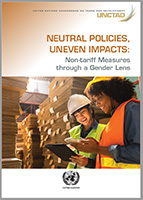Non-tariff measures (NTMs) are trade policy measures designed to achieve public policy objectives such as protecting public health, consumer safety, and the environment. While NTMs often bear high trade costs such as having high information, implementation, and compliance cost, they are usually necessary for achieving economic, social, and other policy goals to ensure product safety and quality for consumers.
In theory, NTMs are designed to have gender-neutral objectives, where a policy requirement is not designed to benefit/protect a particular gender or group of people. In practice, however, the impact of NTMs does not affect women and men identically. Especially, women and men are not equal when it comes to the compliance costs of NTMs and benefiting from the levels of protection provided by NTMs. In terms of compliance with NTMs, for instance, women often face more supply-side constraints, such as having limited access to resources, land, lack of skills and education, time poverty, and mobility constraints among others, which makes it more difficult for women to comply with technical regulations or standards compared to their male counterparts. On benefiting from NTMs protection, women are often disproportionately affected by technical regulations or standards for certain products (specifically products used at workplaces), where they do not consider the physical differences between women and men and are mainly designed with the male anatomy in mind.
Based on the review of a list of literature, case studies, and anecdotes, this study has looked at the gendered impacts of NTMs on women as traders/entrepreneurs, workers, and consumers, respectively, and aims to propose ways in which NTMs related project design, implementation and monitoring can be approached with a gendered lens.
Section II introduces the two key angles with which to approach gender mainstreaming in the context of NTMs.
Section III presents an analysis of the gendered impact of NTMs on women as traders, workers and consumers, respectively.
Section IV concludes with proposing way ahead to addressing the challenges women face with regards to NTMs.
Options to inform project design, implementation and monitoring as well as resource allocation are explored in light of the key findings in Section II.



